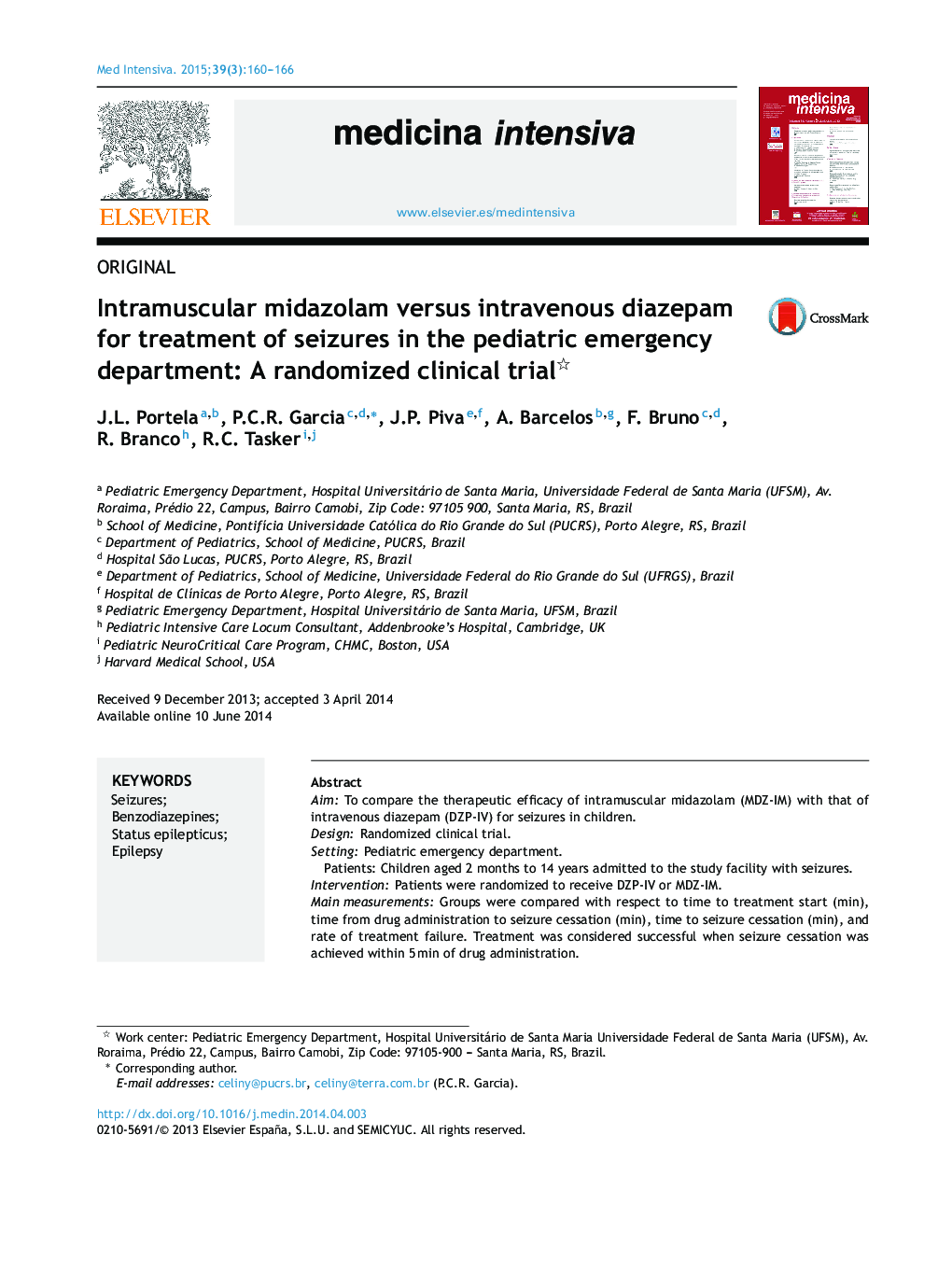| Article ID | Journal | Published Year | Pages | File Type |
|---|---|---|---|---|
| 3112648 | Medicina Intensiva | 2015 | 7 Pages |
AimTo compare the therapeutic efficacy of intramuscular midazolam (MDZ-IM) with that of intravenous diazepam (DZP-IV) for seizures in children.DesignRandomized clinical trial.SettingPediatric emergency department.Patients: Children aged 2 months to 14 years admitted to the study facility with seizures.InterventionPatients were randomized to receive DZP-IV or MDZ-IM.Main measurementsGroups were compared with respect to time to treatment start (min), time from drug administration to seizure cessation (min), time to seizure cessation (min), and rate of treatment failure. Treatment was considered successful when seizure cessation was achieved within 5 min of drug administration.ResultsOverall, 32 children (16 per group) completed the study. Intravenous access could not be obtained within 5 min in four patients (25%) in the DZP-IV group. Time from admission to active treatment and time to seizure cessation was shorter in the MDZ-IM group (2.8 versus 7.4 min; p < 0.001 and 7.3 versus 10.6 min; p = 0.006, respectively). In two children per group (12.5%), seizures continued after 10 min of treatment, and additional medications were required. There were no between-group differences in physiological parameters or adverse events (p = 0.171); one child (6.3%) developed hypotension in the MDZ-IM group and five (31%) developed hyperactivity or vomiting in the DZP-IV group.ConclusionGiven its efficacy and ease and speed of administration, intramuscular midazolam is an excellent option for treatment of childhood seizures, enabling earlier treatment and shortening overall seizure duration. There were no differences in complications when applying MDZ-IM or DZP-IV.
ResumenObjetivoComparar la eficacia de midazolam intramuscular (MDZ-IM) con la de diazepam intravenoso (DZP-IV) para convulsiones en niños.DiseñoEnsayo clínico aleatorizado.ÁmbitoServicio de Urgencias Pediátricas.PacientesNiños de entre 2 meses y 14 años internados con convulsiones.IntervenciónLos pacientes fueron aleatorizados para recibir DZP-IV o MDZ-IM.Mediciones principalesTiempo hasta el inicio del tratamiento (minutos), tiempo entre la administración del medicamento y el cese de la convulsión (minutos), tiempo hasta el cese de la convulsión (minutos), y tasa de fallo del tratamiento. El tratamiento fue considerado exitoso cuando las convulsiones cesaron en los 5 min tras la administración del medicamento.ResultadosCompletaron el estudio 32 niños (16 por grupo). No fue posible obtener acceso intravenoso en 4 pacientes (25%) del grupo DZP-IV. El tiempo entre la internación y el tratamiento fue menor en el grupo MDZ-IM (2,8 vs. 7,4 min; p < 0,001), así como el tiempo hasta el cese de la convulsión (7,3 vs. 10,6 min; p = 0,006). En 2 niños de cada grupo (12,5%), las convulsiones continuaron después de 10 min de tratamiento. No hubo diferencias entre los grupos en los parámetros fisiológicos o eventos adversos (p = 0,171); un niño (6,3%) del grupo MDZ-IM presentó hipotensión, y 5 del grupo DZP-IV (31%) presentaron hiperactividad o vómitos.ConclusiónDada su eficacia, facilidad y velocidad de administración, MDZ-IM es una excelente opción para el tratamiento de convulsiones infantiles, posibilitando un tratamiento precoz y reduciendo la duración de la convulsión. No hubo diferencias en las complicaciones al aplicar MDZ-IM o DZP-IV.
